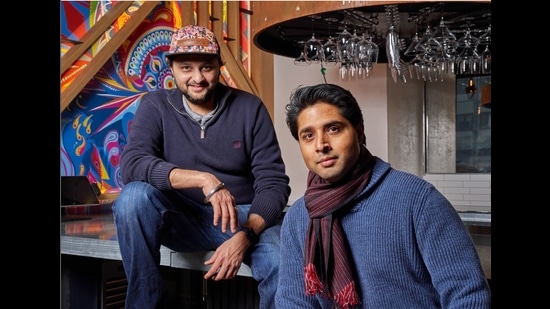Meet the men stirring up a storm with regional khana in NYC
Chef Chintan Pandya and restaurateur Roni Mazumdar, launched their third Indian restaurant, Dhamaka, on Valentine’s Day. make way for pork salad, Champaran Meat and other delicacies.
They say their goal is to simply serve authentic Indian food. If it’s too spicy and deserves to be, so be it. And if it’s oily, and needs to be, that’s how it will be. “Unapologetically”, they insist. And if it means pushing against the status quo, that’s the plan.

Chintan Pandya, 41 and Roni Mazumdar, 38, the New York chef and restaurateur duo that everyone has been talking about in recent years, launched their third Indian restaurant on Valentine’s Day.
Dhamaka follows Rahi (2017), which established them, and Adda Indian Canteen (2018), which set them apart and had diners queuing up around the block on some nights. All three are in New York City. The menu, once again, is their manifesto: to bring Indian cuisines to America, without modifying them. This, they believe has been a misinformed and self-defeating endeavour of many Indian restaurants, to make the fare more palatable to Americans. “Have you seen a French restaurant go the India way?” asks Pandya.
This time, it’s about regional Indian food, dishes that are rarely served outside their immediate neighbourhoods. There’s Doh Khleh, a Meghalaya pork salad; Rajasthani Khargosh, as the name suggests, a Rajasthani preparation of rabbit meat; and Champaran Meat, a mutton dish from Bihar. There’s also Macher Jhol, Bengal fish curry but done with baby shark; and Chenna Poda, a dessert from Odisha. It’s hard to find them all served in any one restaurant, even in India.
Pandya, who worked at New York’s Michelin-starred Junoon in 2016 and 2017, holds Champaran Meat as his most satisfying creation at Dhamaka. It’s a story he tells with some relish. It took him months to get right, testing it in eight or nine clay pots, narrowing it down to one. Finally, they were there.
But they weren’t. Further research — 40% of Pandya’s time goes into R&D even when there is no new project on the anvil — showed that Champaran Meat, as it is cooked in India, calls for mutton. Pandya had been using locally sourced goat. Most diners would not have been able tell the difference, but someone who’d had Champaran Meat in India would have. That triggered a fresh hunt. They eventually found a butcher across the country in Arizona. But there was more. Pandya was “adamant”, says Mazumdar, on putting in a whole pod of garlic in the dish rather than a garlic confit. The chef gets what the chef wants.
Sometimes, however, the chef gets what he did not want, simply because he just did not know it existed. That’s how the Doh Khleh made it to the menu. Neither of them had heard of it. Pandya blames his unfamiliarity with the dish on India’s culinary culture that obscures much of its regional specialties.
“Dude, I have never heard of it and I eat, live and do everything Indian,” Pandya recalled telling Eric Valdez, the 28-year-old Filipino chef de cuisine at Rahi, who first suggested the pork salad. But Valdez persisted, and Doh Khleh made it to the menu after a few test-runs against other Meghalaya offerings.
Are they serving food, or is this some kind of rebellion? Pandya says he has been asked that question before. “I’m just trying to follow what was done,” he says. “I’m trying to simplify the food. We’re trying to simplify the entire objective of the Indian food.”
Mazumdar follows that up, in an email: “We are getting out of the way of Indian cuisine for it to shine in its most unapologetic form. There is a lot of pride that comes with Indian heritage and we are simply sharing that excitement through food and fighting to have a real voice in the American community as Indians (not a diluted / toned down version of Indian).”
Dhamaka’s plan to focus on regional food was no easy decision. Rahi and Adda, after all, set the bar high. With the new restaurant, things had to be fittingly explosive. “I had been doing a lot of research and contemplating different things, but nothing was convincing me or getting me excited,” Pandya says. “It went on for a few months, with Roni chasing me to come up with a theme. I was struggling a lot.”
The Eureka moment came when Pandya was home one evening and his wife asked him if he wanted to eat anything. He did. She quickly made him — he is not allowed to cook at home — tindora and aloo subzi. “I asked myself, ‘How can we have same fresh taste and perspective of Indian food in restaurants?’ That’s how the quest for the menu started, and we began working on regional foods that had not been explored by anyone.”
So, the next time you eat tindora — ivy gourd, if you insist — show some respect.
It can lead to great things.
Catch your daily dose of Fashion, Health, Festivals, Travel, Relationship, Recipe and all the other Latest Lifestyle News on Hindustan Times Website and APPs.



